Optimal Operation of Microgrids Considering Auto-Configuration Function Using Multiagent System
Abstract
:1. Introduction
2. System Model
2.1. Microgrid System Configuration
2.2. State Diagram for Microgrid Operation Modes
3. Auto-Configuration Function
3.1. Definition of Auto-Configuration Function
- Plug and play of smart appliances in smart house/building
- Registration/deregistration of devices owned by the MG operator
- Registration/deregistration of a home/building energy management system
3.2. Sniffer Diagram for Adding/Removing devices
3.3. Operation Algorithm for EMS
4. Mathematical Models
5. Simulation Results
6. Conclusions
Acknowledgments
Author Contributions
Conflicts of Interest
Abbreviations
| Index of time, running from 1 to | |
| T | Set of time intervals |
| i | Index of generator, running from 1 to |
| I | Set of generators |
| l | Index of load, running from 1 to |
| L | Set of loads |
| m | Index of bus, running from 1 to |
| M | Set of buses |
| Production cost of unit i | |
| Min/max production limits of unit i | |
| Start-up cost of unit i | |
| Shut-down cost of unit i | |
| Buying price at t | |
| Selling price at t | |
| , | Forecasted output of PV cell & wind turbine |
| , | Losses for charging/discharging of BESS |
| Capacity of BESS | |
| Total amount of load l at t | |
| Minimum value of state of charge of BESS | |
| Maximum value of state of charge of BESS | |
| Initial value of state of charge of BESS | |
| On or off mode of unit i at t | |
| Operation mode at t | |
| Start-up status of unit i at t | |
| Shut-down status of unit i at t | |
| Generation amount of unit i at t | |
| Charging/discharging power of BESS at t | |
| , | Buying/selling power of MG at t |
| State of charge of BESS at t | |
| Penalty for load shedding at t | |
| Total load shedding amount at t | |
| Total active power line loss at t | |
| The resistance of the cable between buses m and n | |
| The magnitude of the current flows through the line between buses m and n |
References
- Ou, T.C.; Hong, C.M. Dynamic operation and control of microgrid hybrid power systems. Energy 2014, 66, 314–323. [Google Scholar] [CrossRef]
- Ou, T.C.; Lu, K.H.; Huang, C.J. Improvement of transient stability in a hybrid power multi-system using a designed NIDC (Novel Intelligent Damping Controller). Energies 2017, 10, 488. [Google Scholar] [CrossRef]
- Ou, T.C.; Su, W.F.; Liu, X.Z.; Huang, S.J.; Tai, T.Y. A modified bird-mating optimization with hill-climbing for connection decisions of transformers. Energies 2016, 9, 671. [Google Scholar] [CrossRef]
- Ou, T.C. A novel unsymmetrical faults analysis for microgrid distribution systems. Int. J. Electr. Power. Energy Syst. 2012, 43, 1017–1024. [Google Scholar] [CrossRef]
- Ou, T.C. Ground fault current analysis with a direct building algorithm for microgrid distribution. Int. J. Electr. Power. Energy Syst. 2013, 53, 867–875. [Google Scholar] [CrossRef]
- Zamani, M.A.; Sidhu, T.S.; Yazdani, A. Investigations into the control and protection of an existing distribution network to operate as a microgrid: A case study. IEEE Trans. Ind. Electron. 2014, 61, 1904–1915. [Google Scholar] [CrossRef]
- Kim, H.M.; Kinoshita, T.; Shin, M.C. A multiagent system for autonomous operation of islanded microgrids based on a power market environment. Energies 2010, 3, 1972–1990. [Google Scholar] [CrossRef]
- Hatziargyriou, N.; Asano, H.; Iravani, R.; Marnay, C. Microgrids. IEEE Power Energy Mag. 2007, 5, 78–94. [Google Scholar] [CrossRef]
- Bui, V.H.; Hussain, A.; Nguyen, T.T.; Kim, H.M. Real-time optimization for microgrid operation based on auto-configuration in grid-connected mode. In Proceedings of the 2016 IEEE International Conference, Vietnam, Hanoi, 14–16 November 2016. [Google Scholar]
- Kim, H.M.; Lim, Y.; Kinoshita, T. An intelligent multiagent system for autonomous microgrid operation. Energies 2012, 5, 3347–3362. [Google Scholar] [CrossRef]
- Bui, V.H.; Hussain, A.; Kim, H.M. Optimal microgrid operation considering auto-configuration in islanded mode. In Proceedings of the 2016 IEEE International Conference, Vietnam, Hanoi, 14–16 November 2016. [Google Scholar]
- Katiraei, F.; Iravani, R.; Hatziargyriou, N.; Dimeas, A. Microgrid management. IEEE Power Energy Mag. 2008, 6, 54–65. [Google Scholar] [CrossRef]
- Su, W.; Wang, J. Energy management systems in microgrid operations. Electr. J. 2012, 25, 45–60. [Google Scholar] [CrossRef]
- Hussain, A.; Bui, V.H.; Kim, H.M. A resilient and privacy-preserving energy management strategy for networked microgrids. IEEE Trans. Smart Grid 2017, 99, 1. [Google Scholar] [CrossRef]
- Bui, V.H.; Hussain, A.; Kim, H.M. A multiagent-based hierarchical energy management strategy for multi-microgrids considering adjustable power and demand response. IEEE Trans. Smart Grid 2017, 99, 1. [Google Scholar] [CrossRef]
- Deng, W.; Pei, W.; Shen, Z.; Zhao, Z.; Qu, H. Adaptive micro-grid operation based on IEC 61850. Energies 2015, 8, 4455–4475. [Google Scholar] [CrossRef]
- Hussain, A.; Bui, V.H.; Kim, H.M. Robust optimization-based scheduling of multi-microgrids considering uncertainties. Energies 2016, 9, 278. [Google Scholar] [CrossRef]
- Mohan, V.; Suresh, R.; Singh, J.G.; Ongsakul, W.; Madhu, N. Microgrid energy management combining sensitivities, interval and probabilistic uncertainties of renewable generation and loads. IEEE J. Emerg. Sel. Top. Circuits Syst. 2017, 7, 262–270. [Google Scholar] [CrossRef]
- Deng, W.; Pei, W.; Qi, Z. Microgrid information exchange based on IEC 61850. Autom. Electr. Power Syst. 2013, 37, 6–11. [Google Scholar]
- Gomez-Sanz, J.J.; Garcia-Rodriguez, S.; Cuartero-Soler, N.; Hernandez-Callejo, L. Reviewing microgrids from a multi-agent systems perspective. Energies 2014, 7, 3355–3382. [Google Scholar] [CrossRef]
- Bogaraj, T.; Kanakaraj, J. Intelligent energy management control for independent microgrid. Sādhanā 2016, 41, 755–769. [Google Scholar] [CrossRef]
- Dimeas, A.L.; Hatziargyriou, N.D. Operation of a multiagent system for microgrid control. IEEE Trans. Power Syst. 2005, 20, 1447–1455. [Google Scholar] [CrossRef]
- Yu, X.; Wang, F.; Huang, A.Q. Power management strategy for plug and play DC microgrid. In Proceedings of the 2012 3rd IEEE PES International Conference, Berlin, Germany, 14–17 October 2012. [Google Scholar]
- Hou, C.; Hu, X.; Hui, D. Plug and play power electronics interface applied in microgrid. In Proceedings of the 2011 4th International Conference, Weihai, China, 6–9 July 2011. [Google Scholar]
- Tucci, M.; Riverso, S.; Ferrari-Trecate, G. Line-independent plug-and-play controllers for voltage stabilization in dc microgrids. IEEE Trans. Control Syst. Technol. 2017, PP, 1–9. [Google Scholar] [CrossRef]
- Ito, Y.; Zhongqing, Y.; Akagi, H. DC microgrid based distribution power generation system. In Proceedings of the 4th International Power Electronics and Motion Control Conference (IPEMC 2004), Xi’an, China, 14–16 August 2004. [Google Scholar]
- Crisostomi, E.; Liu, M.; Raugi, M.; Shorten, R. Plug-and-play distributed algorithms for optimized power generation in a microgrid. IEEE Trans. Smart Grid 2014, 5, 2145–2154. [Google Scholar] [CrossRef]
- Laaksone, H.; Kauhaniemi, K. Fault type and location detection in islanded microgrid with different control methods based converters. In Proceedings of the 19th International Conference on Electricity Distribution, Vienna, Austria, 21–24 May 2007. [Google Scholar]
- Nikkhajoei, H.; Lasseter, R.H. Microgrid protection. In Proceedings of the IEEE 2007 Power Engineering Society General Meeting, Tampa, FL, USA, 24–28 June 2007. [Google Scholar]
- FIPA, The Foundation for Intelligent Physical Agents standards. Available online: http://www.fipa.org (accessed on 7 September 2017).
- Zehir, M.A.; Batman, A.; Sonmez, M.A.; Font, A.; Tsiamitros, D.; Stimoniaris, D.; Kollatou, T.; Bagriyanik, M.; Ozdemir, A.; Dialynas, E. Impacts of microgrids with renewables on secondary distribution networks. Appl. Energy 2017, 201, 308–319. [Google Scholar] [CrossRef]
- Java Agent Development Environment (JADE). Available online: http://jade.tilab.com (accessed on 7 September 2017).
- IBM ILOG CPLEX V12.6 User’s Manual for CPLEX 2015, CPLEX Division; ILOG: Incline Village, NV, USA, 2015; Available online: https://www.ibm.com/support/knowledgecenter/SSSA5P_12.6.2/ilog.odms.studio.help/pdf/usrcplex.pdf (accessed on 7 September 2017).
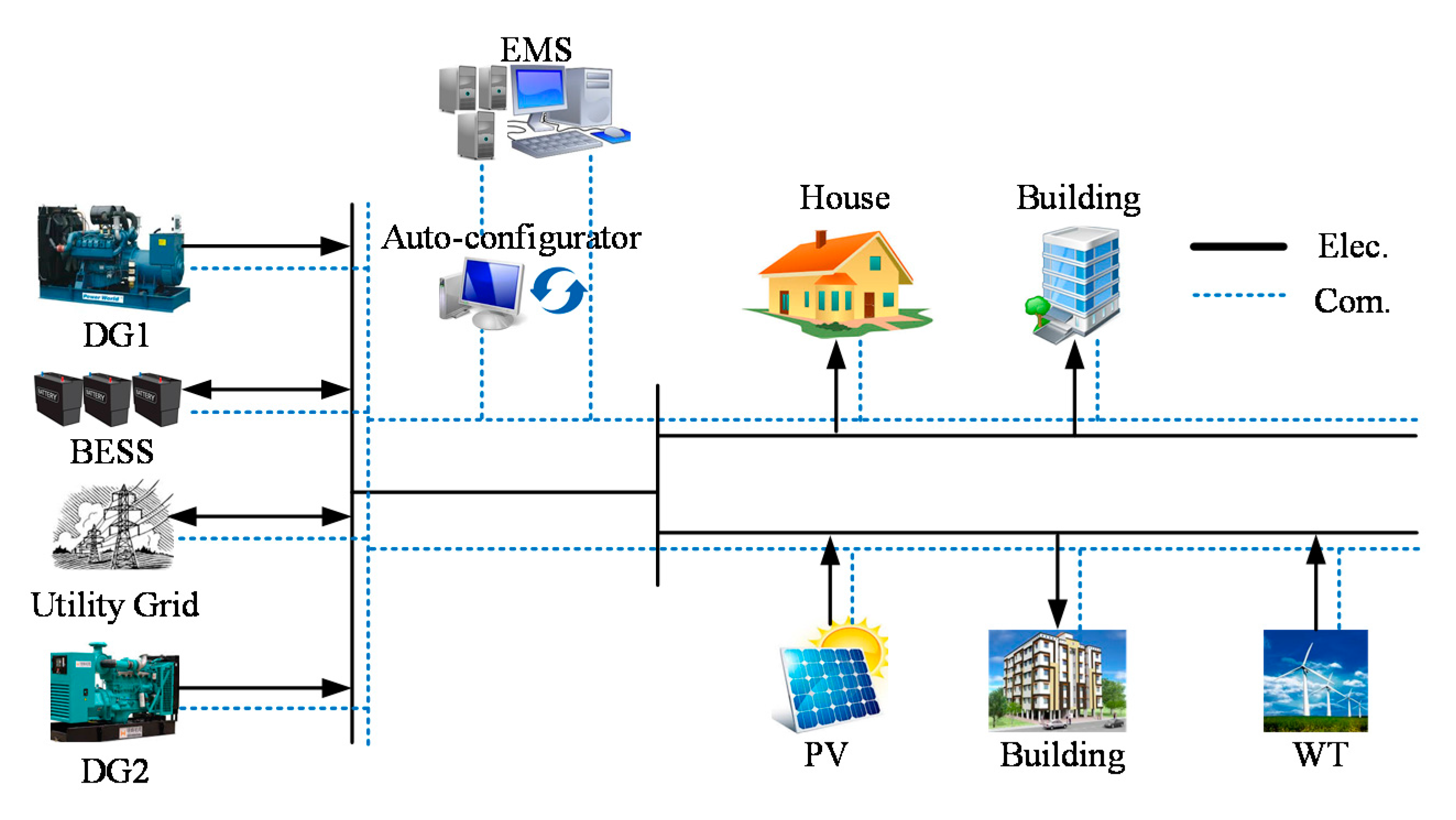
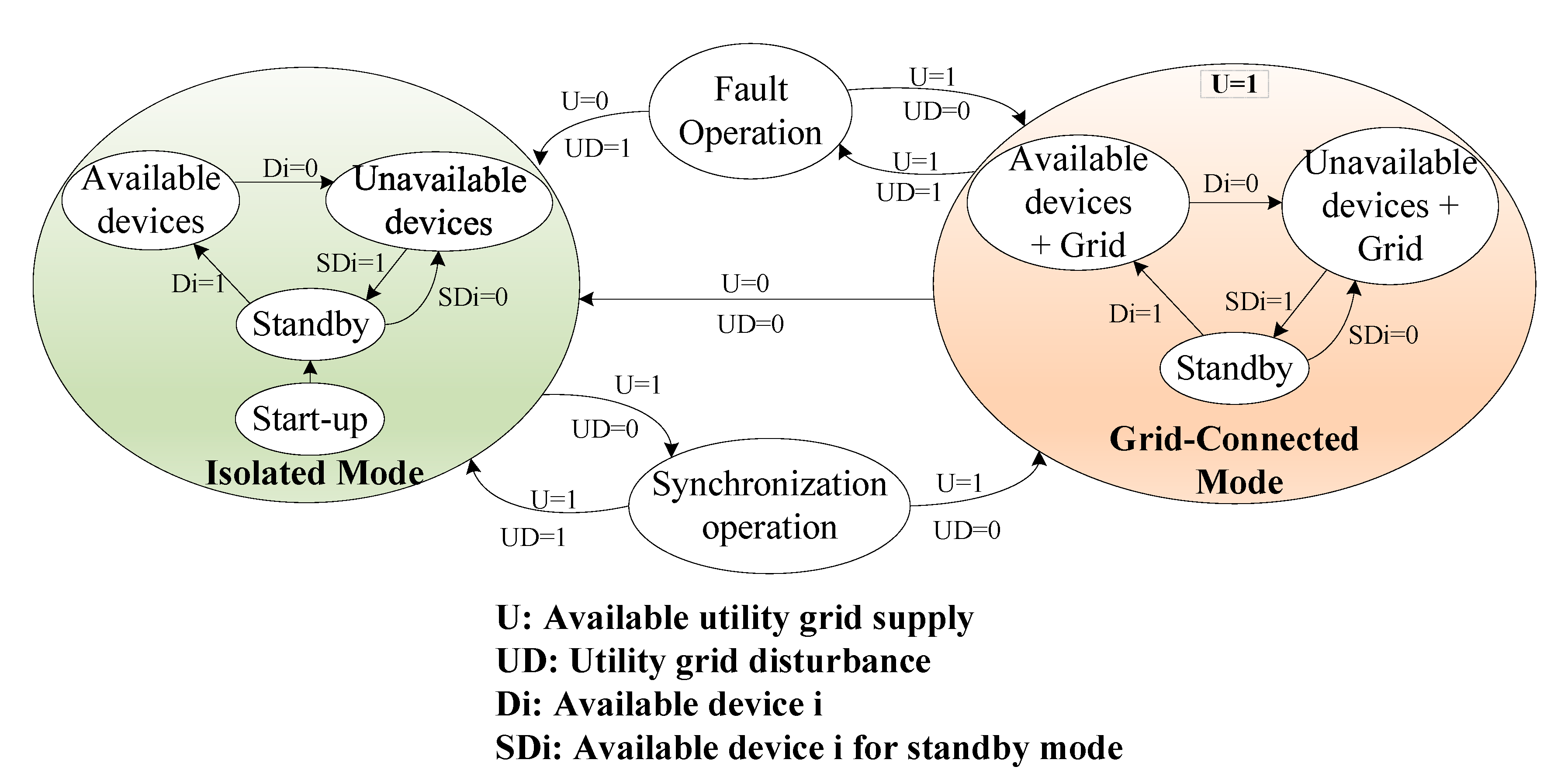

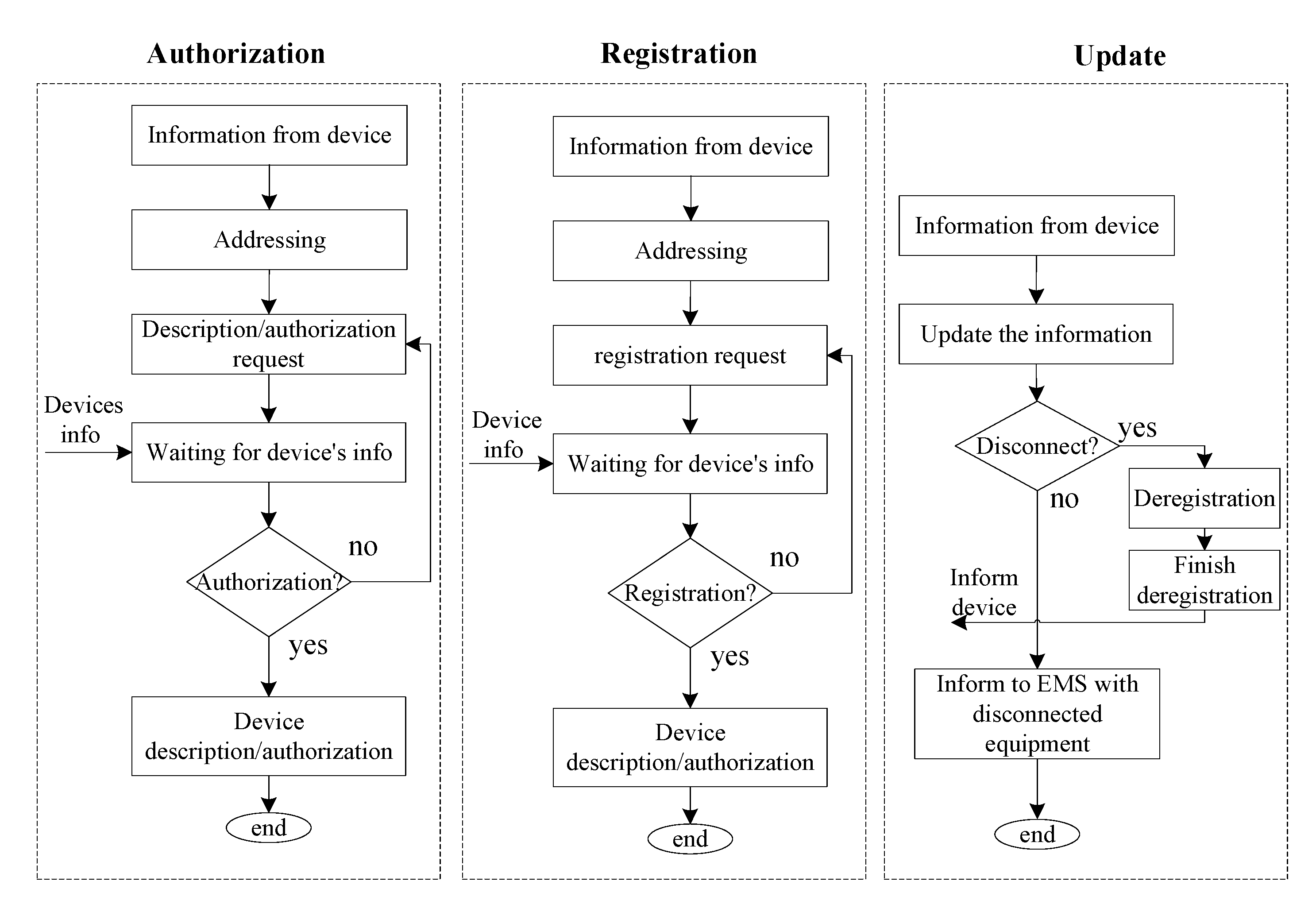
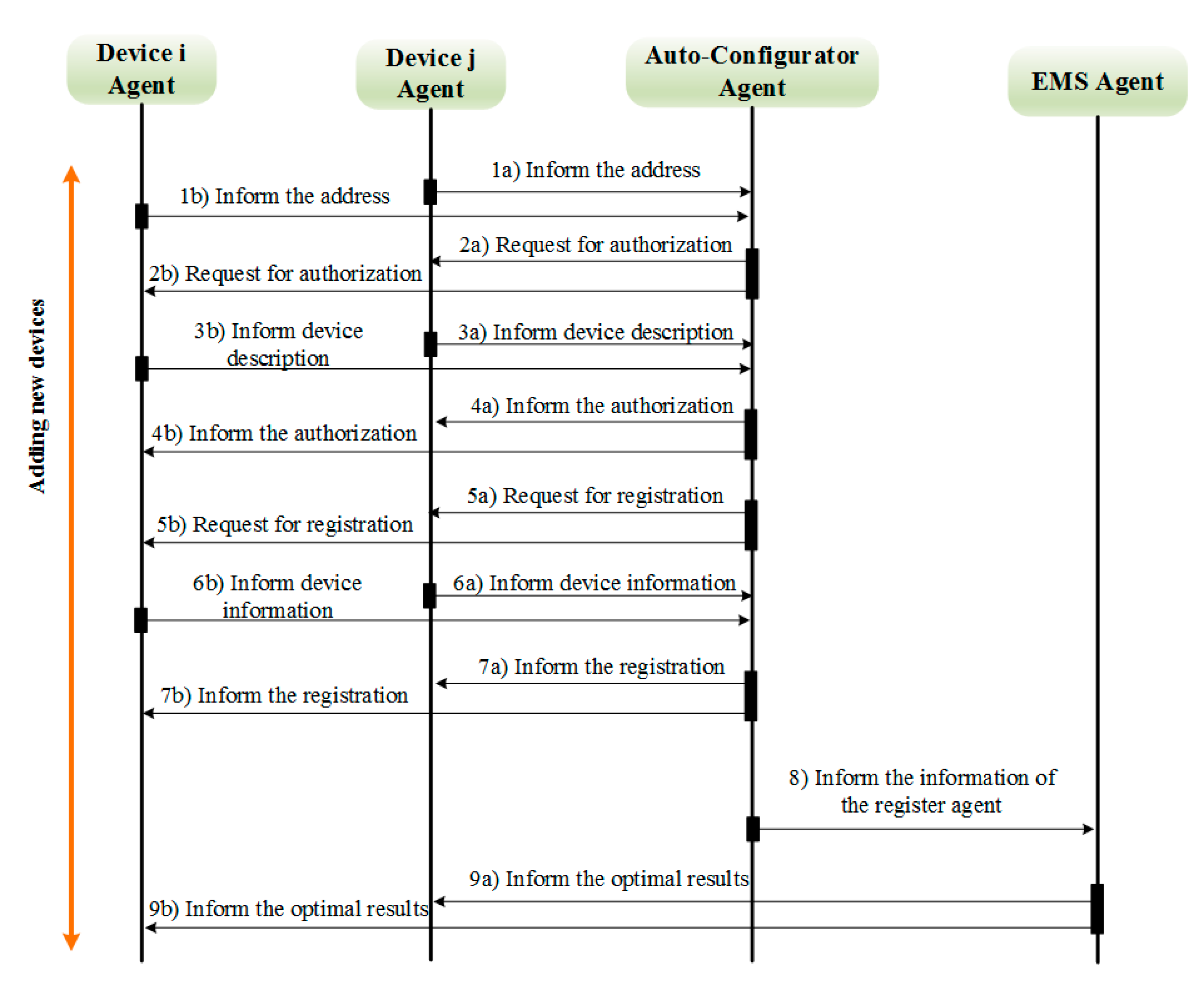

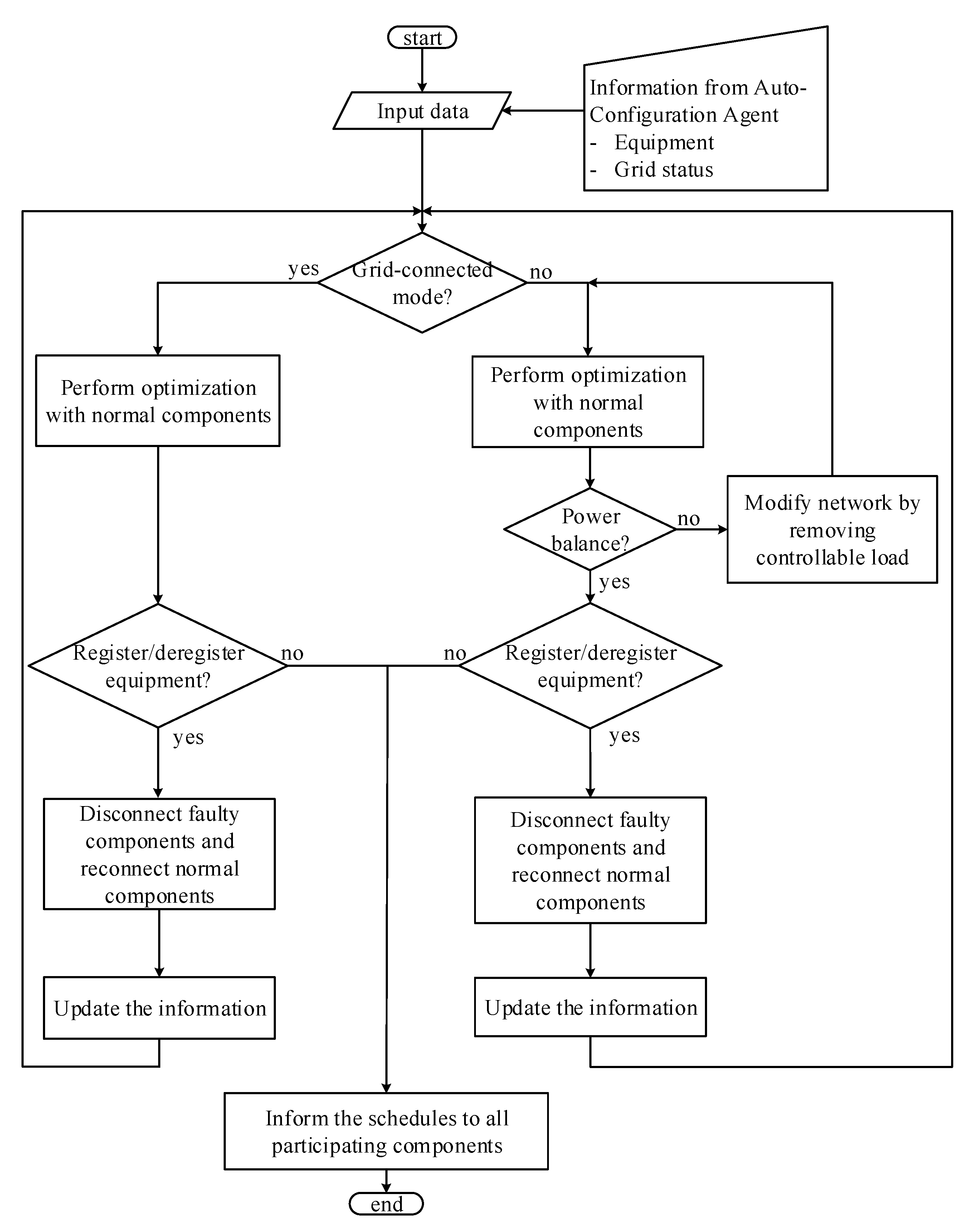

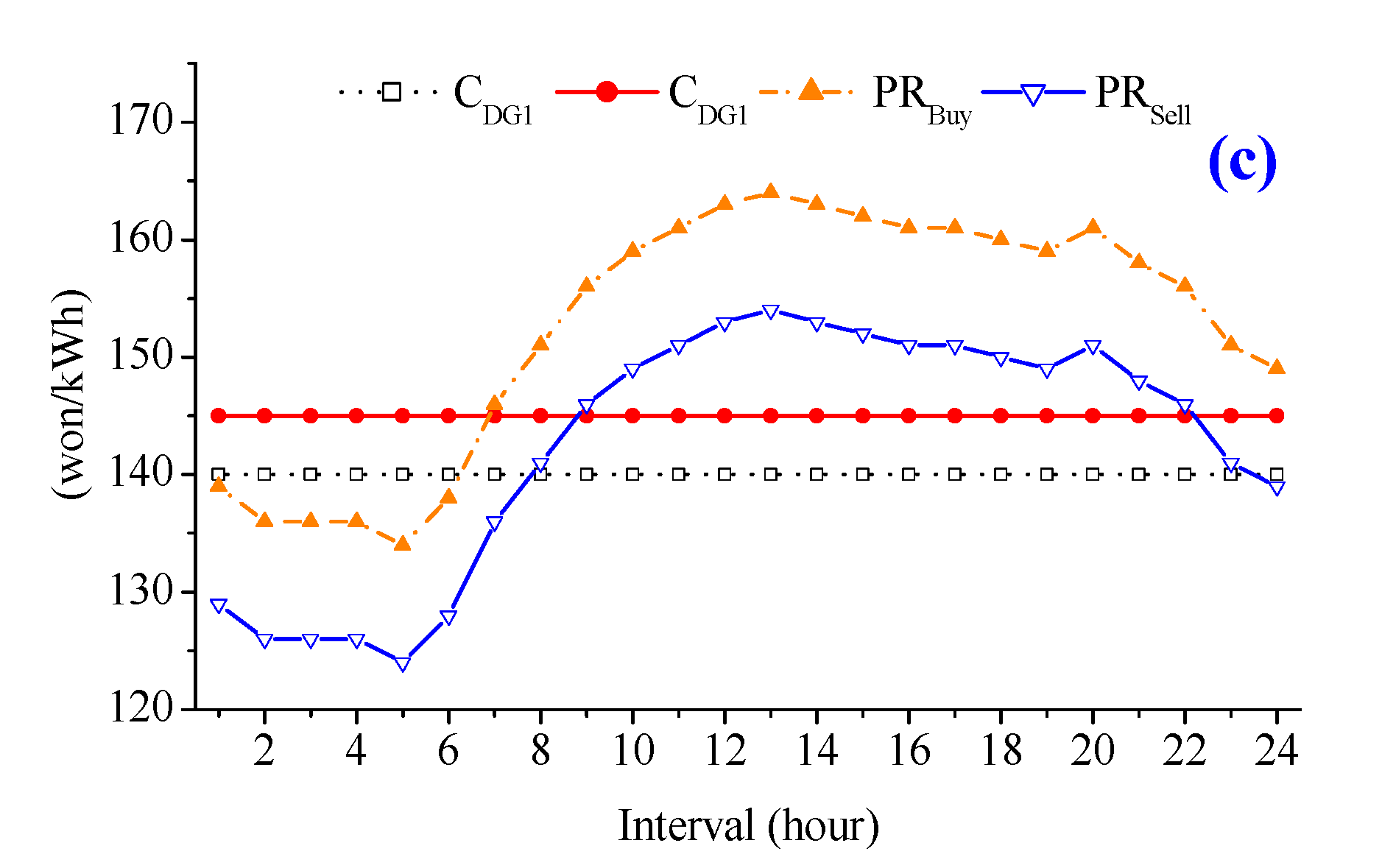
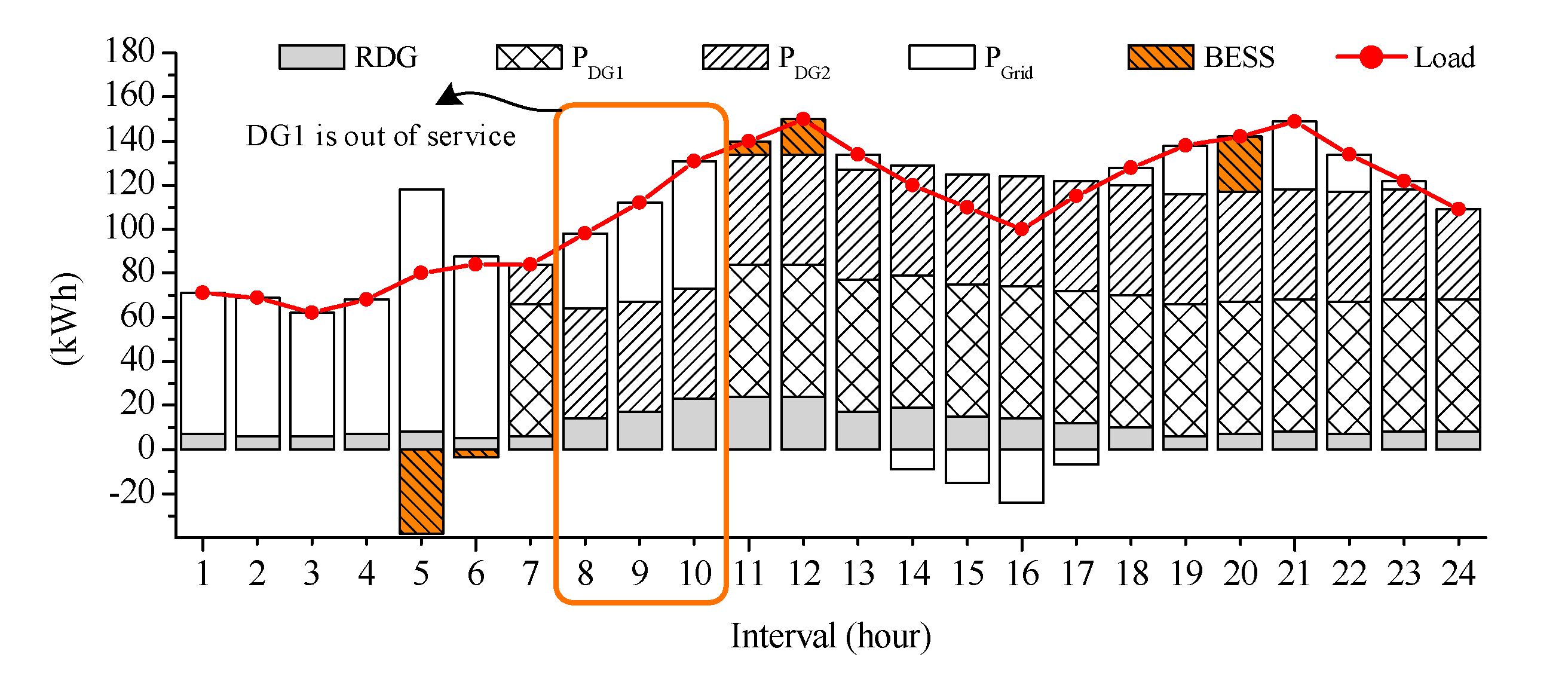
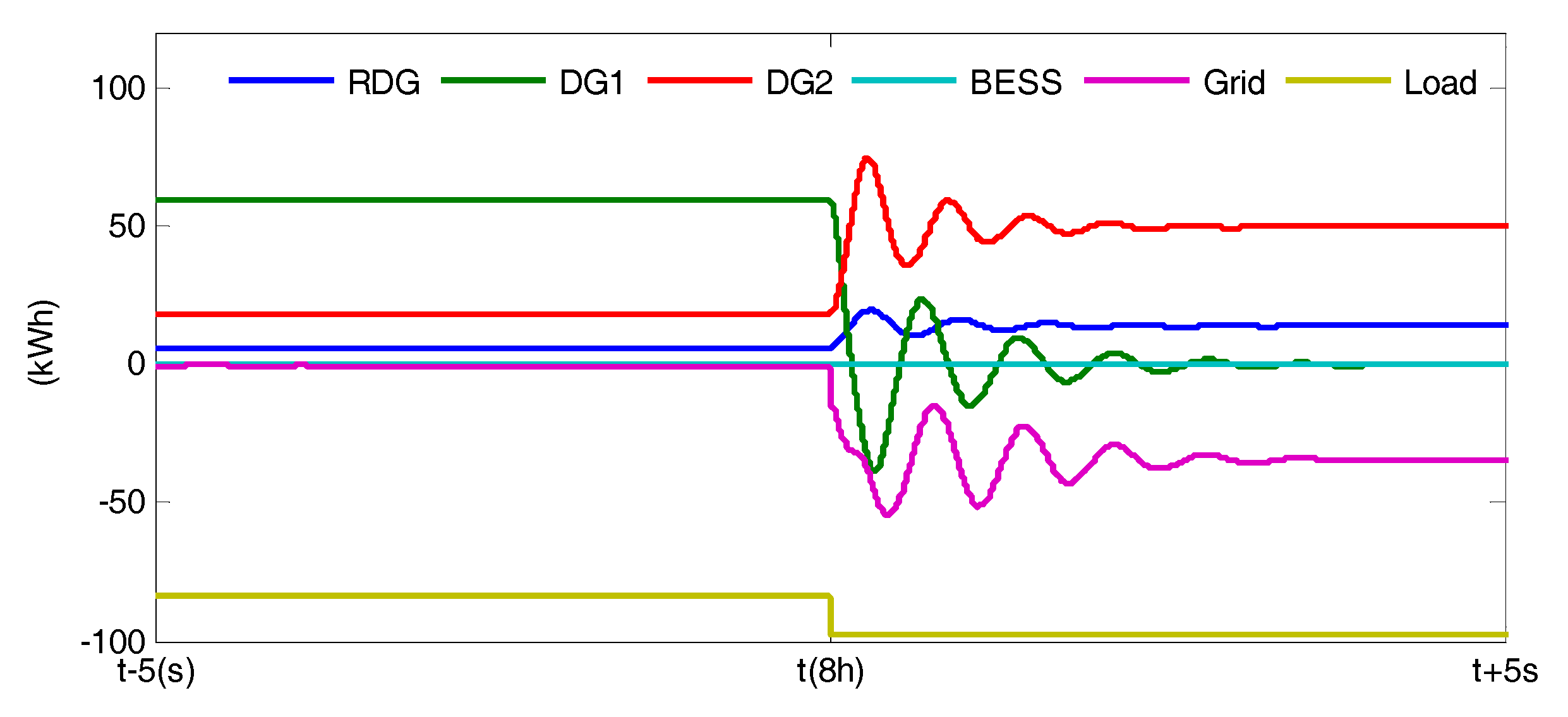

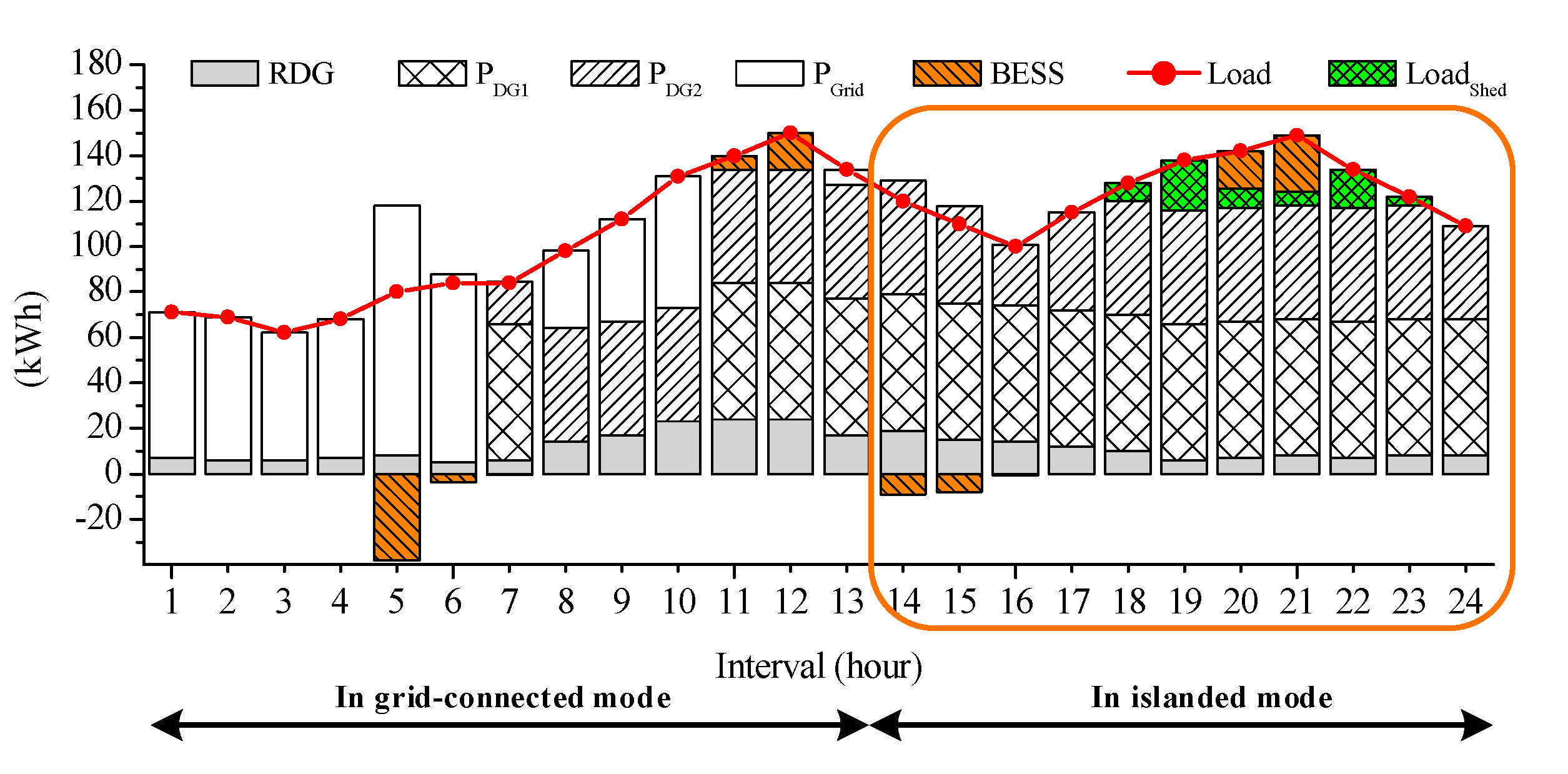
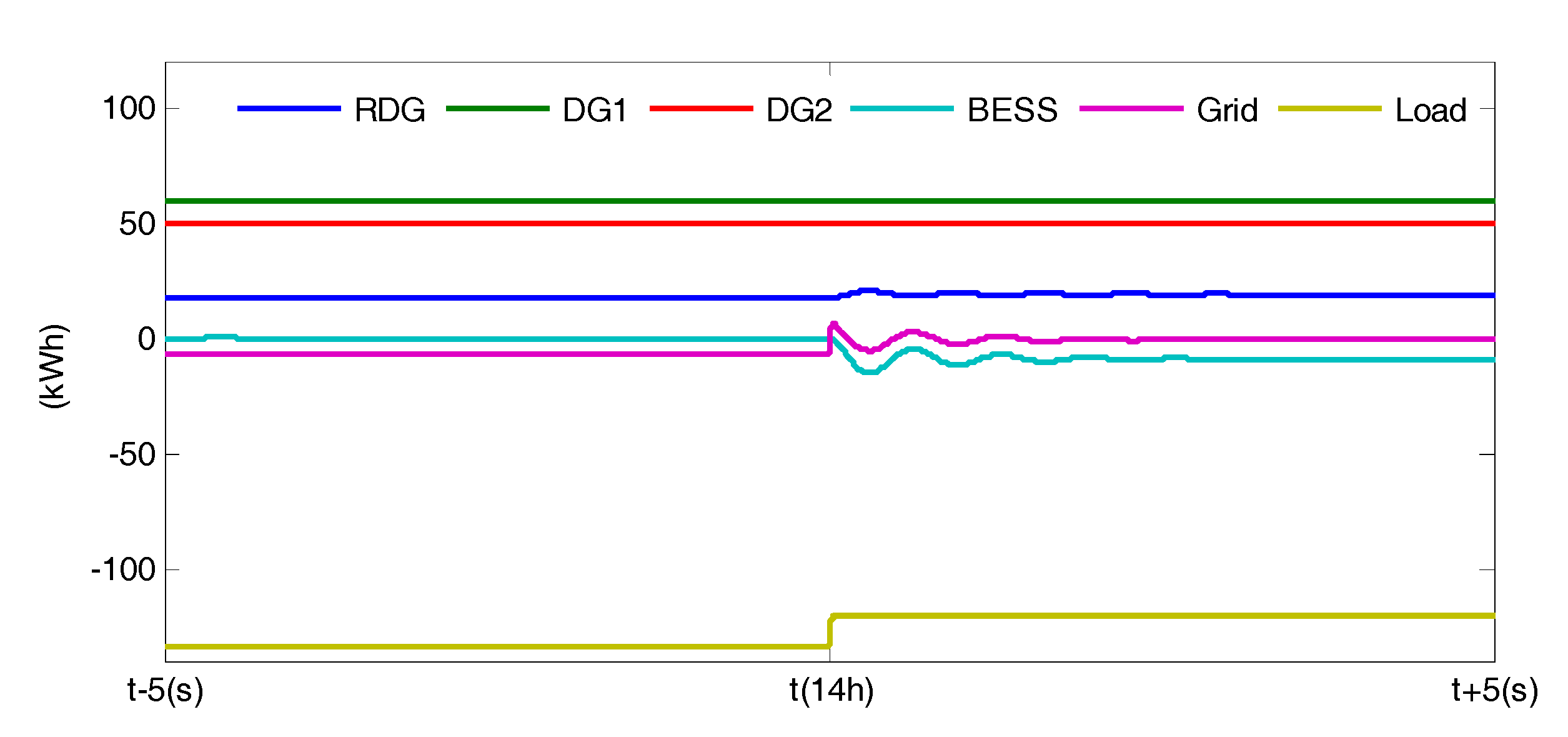

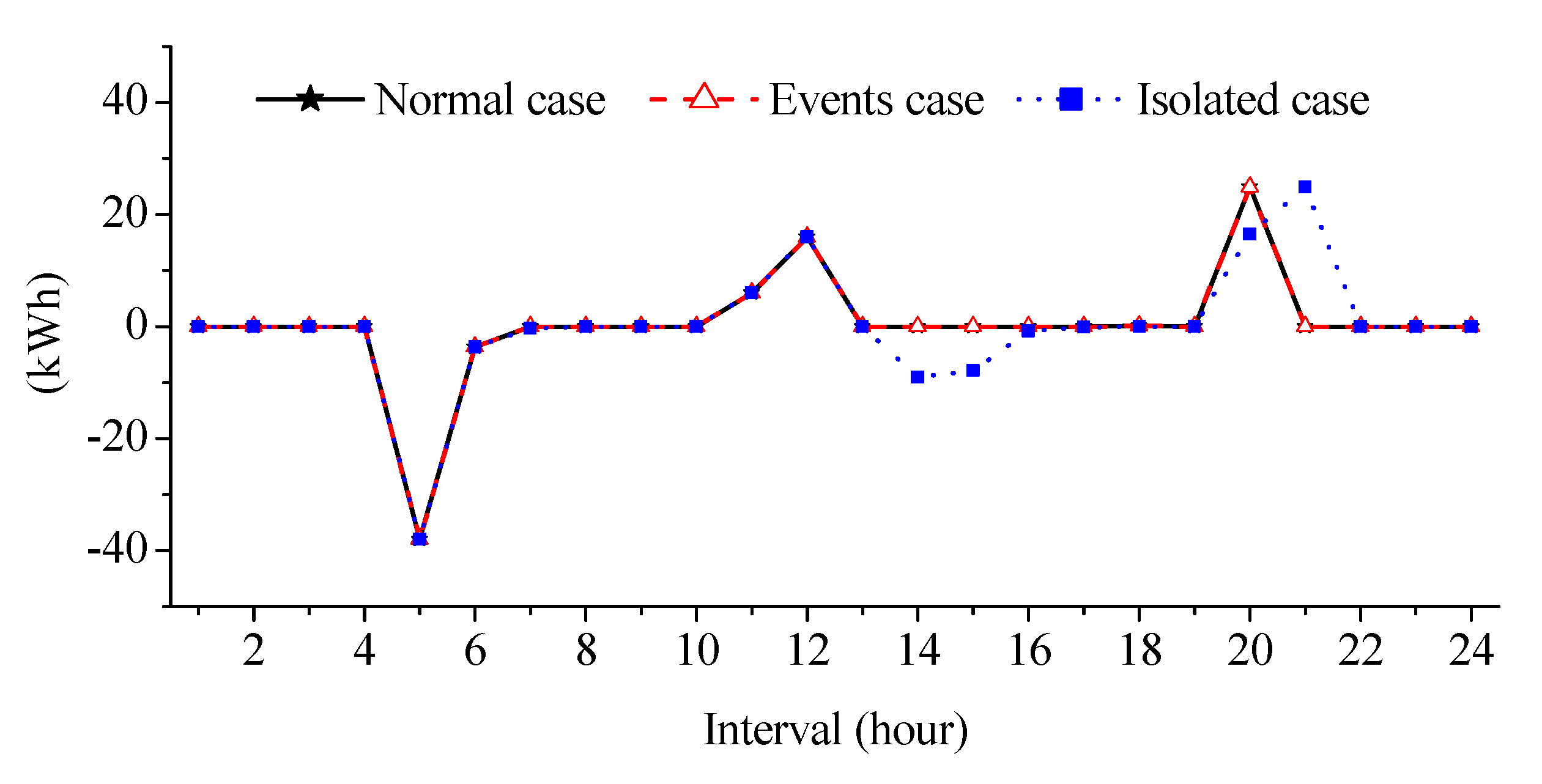
| Parameters | DG1 | DG2 | Parameters | BESS |
|---|---|---|---|---|
| Cost/kWh | 140 | 145 | Capacity | 50 |
| Start-up cost | 200 | 200 | Min | 0 |
| Shut-down cost | 100 | 100 | Initial | 10 |
| Min | 0 | 0 | Char. Loss (%) | 5 |
| Max | 60 | 50 | Dis. Loss (%) | 5 |
© 2017 by the authors. Licensee MDPI, Basel, Switzerland. This article is an open access article distributed under the terms and conditions of the Creative Commons Attribution (CC BY) license (http://creativecommons.org/licenses/by/4.0/).
Share and Cite
Bui, V.-H.; Hussain, A.; Kim, H.-M. Optimal Operation of Microgrids Considering Auto-Configuration Function Using Multiagent System. Energies 2017, 10, 1484. https://doi.org/10.3390/en10101484
Bui V-H, Hussain A, Kim H-M. Optimal Operation of Microgrids Considering Auto-Configuration Function Using Multiagent System. Energies. 2017; 10(10):1484. https://doi.org/10.3390/en10101484
Chicago/Turabian StyleBui, Van-Hai, Akhtar Hussain, and Hak-Man Kim. 2017. "Optimal Operation of Microgrids Considering Auto-Configuration Function Using Multiagent System" Energies 10, no. 10: 1484. https://doi.org/10.3390/en10101484





